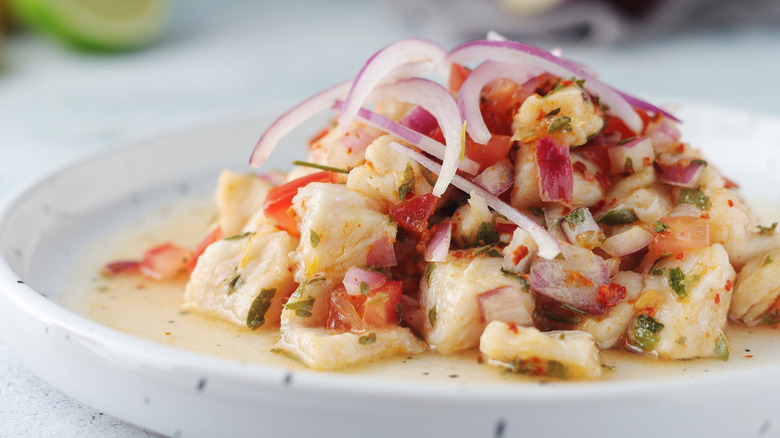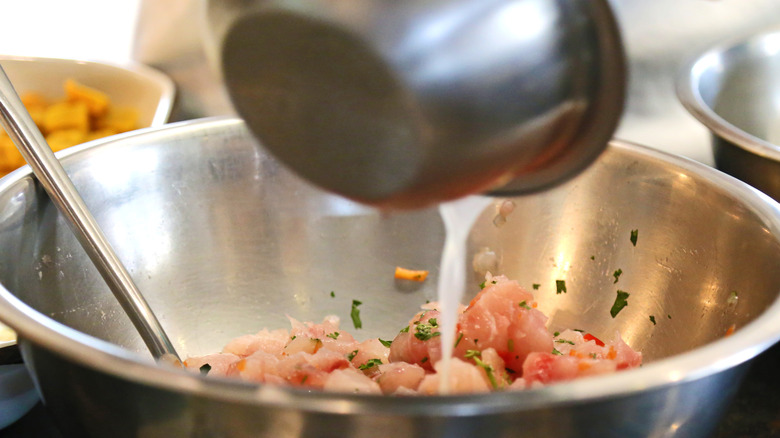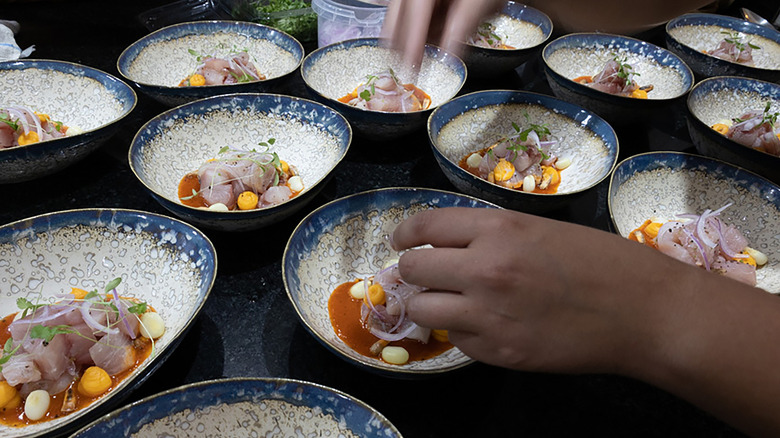There Are Strict Rules To Follow For Eating Peru's Mouth-Watering National Dish
There is an ongoing debate in the world of gastronomy surrounding one of the most beloved fish dishes in existence: ceviche. With is origins debated throughout Latin America, substantial evidence points to ceviche originating on the Pacific coast of pre-Colombian Peru. Some say Polynesian voyagers, who traditionally ate marinated raw fish, took their culinary knowledge across the Pacific where it evolved into the dish we know and love, whereas others view Peru's Indigenous Moche people as the inventors.
Though many countries have developed their own signature ways of preparing ceviche, Peru is the only country that claims it as its national dish, with historical sources indicating that it may have been consumed by Peruvians for over 2,000 years. Suffice to say that after two millennia, the country folk have perfected the art of preparing and eating the cool and zesty dish, making sure to adhere to certain standards to protect the authenticity of this national gastronomic treasure. How and when you eat this dish is of the highest importance, with two important rules to remember: only eat ceviche for lunch and make sure to wait a few minutes before digging in.
Peru's ceviche rules
Before feasting on this fishy treat, you'll need to make a lunch reservation. The first national rule is that ceviche is only eaten before 3 p.m. It is rarely served for dinner in Peru, with many ceviche restaurants closing in the early afternoon, as Peruvians know that ceviche is best when fresh, using seafood caught first thing in the morning. If you see ceviche on a dinner menu, it may be a sign of a tourist trap restaurant and likely means the fish has been frozen.
The second rule is to wait a few minutes after you've been served to tuck into your bowl of ceviche so you can let the raw fish thoroughly marinade and be "cooked" in the lime juice on the plate. Remembering these rules can help you achieve cultural chameleonism and get the most out of this ancient cultural delicacy.
You'll find ceviche everywhere in Lima, in high-end restaurants and at budget-friendly market stalls. With so many regional varieties, it's worth factoring the exploration of ceviche into your Peruvian travel plans as you'll be sure to want to try the Amazonian version that uses dorado or paiche fish, and the Andes version which has a base of trout. With all the love and attention, not to mention thousands of years of tradition, put into the preparation of each bowl of ceviche in Peru, why spoil it by not adhering to the local etiquette surrounding it?
How tiger's milk makes it unique
To better understand the Peruvian art of eating ceviche, we must first look at the specificities of the national style of this dish. With myriad forms of ceviche existing globally, including Mexican, Cuban, Tahitian, and Thai variations, among many more, what makes Peruvian ceviche so special? What may surprise you is that Peru's secret ingredient doesn't necessarily have to do with the fish itself, with Pacific sea bass, black clam, shrimp, or medley versions of ceviche in existence, but with its secret ingredient, "leche de tigre," which translates to "tiger's milk." This is the marinade in which the raw fish is "cooked" by the citrus is typically made from limes, onion, salt, pepper, and aji, a spicy yellow Peruvian chile pepper. However, there is no set way of making this marinade, with each chef having their own preference. The main thing that sets Peruvian ceviche apart from the rest is a Peruvian lime, which is highly acidic and sour, possessing a specific flavor similar to Key limes.
The dish is elevated by the use of complementing ingredients, including finely sliced red onions, sweet potato, and chunky kernels of choclo, a regional type of field corn found at high altitudes. Of course, without the freshest catch of the day, all this pre-preparation would be useless, as the next most important element of ceviche is only using the freshest fish available.


